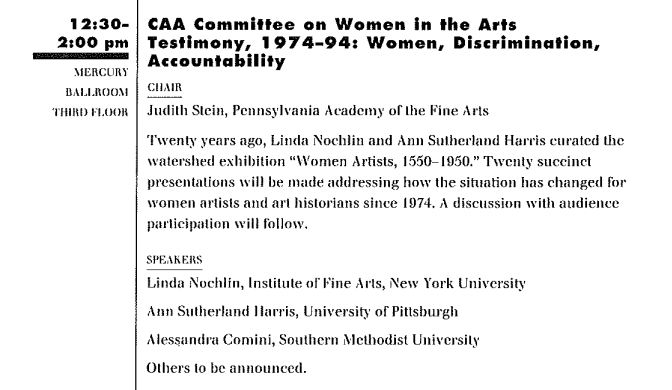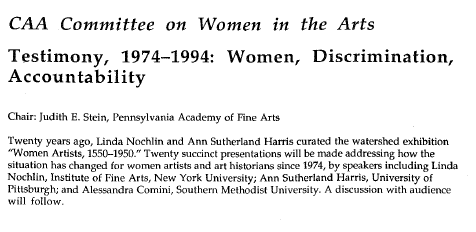CAA News Today
CAA’s Committee on Women in the Arts, Archival Recordings from the 1994 Annual Conference
posted Aug 18, 2022

Entry in 1994 Annual Conference program of the Committee on Women in the Arts’ session.

Abstract entry of the Committee on Women in the Arts session in the 1994 Annual Conference abstracts program.
Fifty years ago in 1972, CAA founded its first committees devoted to women in the arts. This year we celebrate the 50th anniversary of this history by sharing historic materials from CAA members and archives that intersect with feminism at the organization, CAA’s Committee on Women in the Arts, and from its Affiliated Societies, the Women’s Caucus for Art (WCA) and The Feminist Art Project (TFAP). CAA established the Committee on the Status of Women (COSW), the first committee to focus on women in CAA’s history, in 1972. The COSW was renamed the Committee on Women in the Arts (CWA) in 1996, and it continues to promote women in the visual arts field.
In 1994, CAA’s Committee on Women in the Arts held a panel chaired by Judith Stein that featured speakers Linda Nochlin, Ann Sutherland Harris, and Alessandra Comini. Their individual presentations look at the progress of women artists and art historians over the previous twenty years, since 1974. The talks use the exhibition, Women Artists 1550-1950, curated by Nochlin and Harris, as a benchmark for discussion. This landmark exhibition toured four American museums in 1976-77, such as the Brooklyn Museum in 1977, and raised public awareness of the many gifted women painters, sculptors, and architects.
The talks in this session compare and contrast the attitudes that prevailed when the show was being organized with views in the nineties. Releasing these recordings of the session almost another twenty years later, it is an opportunity to reassess the status of women in the arts once again.
Biographies of the speakers:
Judith E. Stein chaired CAA’s Committee on Women in the Arts from 1992 to 1997, initiating a series of awards to women in the arts. A writer and curator, Stein studied at Barnard College, and has a Ph.D. in art history from the University of Pennsylvania.
Stein was recently awarded the Lifetime Achievement Award by the Women’s Caucus for Art (WCA) in 2020. She has written at length on feminism and women artists, beginning with her 1981 doctoral thesis on the neoclassic iconography of Sappho, one of the first feminist dissertations in art history at the University of Pennsylvania. She helped organize Philadelphia Focuses on Women in the Visual Arts (FOCUS) in 1973-74 and edited the WCA’s newsletter from 1975 to 1977. She was also a member of the WCA national advisory board from 1979 to 1981. Her first piece of art criticism was published in Art in America in 1974, reviewing a Judy Chicago exhibition. She also wrote on Cecilia Beaux, the first woman to teach at the Pennsylvania Academy of the Fine Arts, Feminist Art Journal, Winter (1975–1976). Her work has also appeared in Art News, The New York Times Book Review, and the National Public Radio’s Fresh Air and Morning Edition.
Stein served on the advisory board of Philadelphia’s Leeway Foundation for women artists, (1994–2002) and was the first curator of Leeway Founder Linda Alter’s collection of art by American women artists. Stein wrote the foundational essay for Making Their Mark: Women Artists Move into the Mainstream, 1970–1985 (Abbeville, 1989) and “Collaboration,” for The Power of Feminist Art (Harry N. Abrams, 1994). She curated The Likeness of Being: Contemporary Self-Portraits by Sixty Women (DC Moore Gallery, New York, 2000), and co-curated Picturing the Modern Amazon: The Hypermuscular Woman (The New Museum of Contemporary Art, New York, 2000).
She is the author of Eye of the Sixties, Richard Bellamy and the Transformation of Modern Art, (Farrar, Straus & Giroux, 2016). Other curatorial projects by Stein include Red Grooms, A Retrospective for the Pennsylvania Academy of the Fine Arts, and I Tell My Heart: The Art of Horace Pippin, which traveled to the Metropolitan Museum of Art in 1995 and earned a best catalogue award from AICA/USA.
Among her honors is a Creative Capital/Andy Warhol Foundation Arts Writers Grant; a Pew Fellowship for literary non-fiction; and a Lannan Foundation writing residency in Marfa, Texas. Learn more about Judith Stein’s career on her webpage and in this WCA announcement.
Alessandra Comini is University Distinguished Professor of Art History Emerita at Southern Methodist University in Dallas, Texas. She received her B. A. degree from Barnard College, her M. A. from the University of California at Berkeley, and her Ph.D. “with distinction” from Columbia University where she taught for ten years. She has also taught at the University of California, Berkeley, Yale University, served as the Alfred Hodder Resident Humanist at Princeton University, and was named Distinguished Visiting Lecturer at Oxford University‘s European Humanities Research Centre (1996). Voted “outstanding professor” by her students sixteen times, she has been extended the Distinguished Teaching Prize of the Meadows School of the Arts and the United Methodist Church Scholar/Teacher of the Year Award (1996).
An undergraduate and a graduate scholarship in Comini’s name have been established by former students, one a professor of surgical oncology in Little Rock, Arkansas; the other, founder and co-owner of an international antiques business in Dallas. The author of major essays and eight books, one of them nominated for the National Book Award (see publications), Dr. Comini was awarded the Grand Decoration of Honor by the Republic of Austria in recognition of her contributions to Germanic culture in 1990. Her lively revisionist work in the history of women artists was acknowledged in 1995 by the Women’s Caucus for Art with the coveted Lifetime Achievement Award. A vibrant lecturer in both English and German, she is in great demand in America and abroad as a speaker in her chosen fields of art and cultural history as well as musical iconography (see lectures)…. (Source: https://www.alessandracomini.com/introduction/)
Ann Sutherland Harris was born in Cambridge, England and was educated in both the USA and the UK (BA 1961 & PhD 1965, University of London at the Courtauld Institute of Art). She has lived in the States since 1965, teaching at Barnard College and Columbia University, and at several other universities before joining the faculty of the University of Pittsburgh as Professor of the History of Art and Architecture in 1984. There she taught a variety of courses to under- graduate and graduate students. She retired from teaching in 2012.
Harris’s research focuses mainly on 17th century Europe, especially painters and sculptors working in Italy and France. She has a particular interest in artists’ drawings and what they reveal about artists’ ideas and intentions, as well as in artists’ self-perceptions and the roles they play as they interact with patrons and their demands. She has published books about Andrea Sacchi and Gian Lorenzo Bernini’s drawings and, most recently, a substantial survey of European 17th century art and architecture (Laurence King, London; 2005; 2nd ed. 2008). A full bibliography of her publications is available on her university’s website.
Harris became interested in the past and present situation of women during the late 1960s and 1970s, when she became an activist for improved status for women in academe. She testified before the US Congress in 1970 about the discrimination faced by women in higher education, and then helped to set up the Women’s Caucus for Art, an advocacy organization for women active as artists, art historians, and museum professionals: she was its first President (1972-74). She also encouraged Wilhelmina Holladay to found a museum devoted to women artists, which she did twenty-five years ago: the National Museum for Women in the Arts in Washington, DC.
Art history and activism came together when Harris and Linda Nochlin co-curated the traveling exhibition Women Artists, 1550-1950 for the Los Angeles County Museum in 1976-7 (also shown at the University Art Museum, Austin, Texas; the Carnegie Museum of Art, Pittsburgh; and the Brooklyn Museum, New York). She was responsible for artists active in the 16th to 18th centuries, and Nochlin for the artists working after 1800, and she contributed most of the catalogue entries for the earlier artists as well as an introduction that provided the essential historical background for the pioneering women artists who emerged in Europe in the mid-sixteenth-century. Since then, she has occasionally written about twentieth-century women, including Alice Neel (1900-84), Elizabeth Murray (1940-2006) and Edna Andrade (1917- 2008), as well as contributing catalogue essays, articles and reviews about Artemisia Gentileschi and Sofonisba Anguissola, and a survey of recent scholarship on Sofonisba, Artemisia, Lavinia Fontana and Elisabetta Sirani for the exhibition, Italian Women Artists from the Renaissance to the Baroque held at the women’s museum in Washington in 2007.
Linda Nochlin was an American feminist art historian most well-known for her 1971 article “Why Have There Been No Great Women Artists?,” which widely influenced art history, leading to new research and awareness of history and how it is written, analyzed, and taught, as well as launching the field of feminist art history.
Nochlin graduated from Vassar College in 1951 with a bachelor’s degree in philosophy and earned a master’s degree in English from Columbia University in 1952. Her doctorate in art history from the Institution of Fine Arts at New York University (NYU) focused on realism and Gustave Courbet. From 1952 to 1979, Nochlin taught art history at Vassar and published two books on 19th-century art in 1966, Realism and Tradition in Art, 1848–1900 and Impressionism and Post-Impressionism, 1874–1904. She shifted her focus to feminism in 1969, when she taught one of Vassar’s first art history courses on women, “The Image of Women in the Nineteenth and Twentieth Centuries.” After her landmark article, in 1976 Nochlin co-curated “Women Artists: 1550–1950” with Anne Sutherland Harris.
Nochlin left Vassar for a professorship at the graduate school at the City University of New York, where she stayed from 1980 until 1990. In the eighties she published more on Courbet, such as Courbet Reconsidered (1988) with Sarah Faunce, which was also an exhibition at the Brooklyn Museum. Nochlin also published Women, Art, and Power, and Other Essays (1988) and The Politics of Vision: Essays on Nineteenth-Century Art and Society (1989). Nochlin than taught at Yale University (1990-1992) and then became a professor at NYU.
During this time, she published Women in the 19th Century: Categories and Contradictions (1997), Representing Women (1999), and Bathers, Bodies, Beauty: The Visceral Eye (2006).
In 1972, CAA founded its first committees devoted to women in the arts. As a part of this yearlong 50th anniversary celebration, we are sharing historic materials from CAA members and archives that intersect with feminism at the organization, including CAA’s Committee on Women in the Arts (CWA) and our Affiliated Societies, Women’s Caucus for Art (WCA) and The Feminist Art Project (TFAP).
This celebration culminates in a program and reception at Boston University’s Joan and Edgar Booth Theatre on Friday, September 23, 2022. This program will reflect upon the incredible history of feminist pioneers at the organization while looking toward a more inclusive, equitable future through the continued work of the CWA. The members of CWA are carrying the torch of feminism during this crucial time of precarity for women’s rights.
Over the next couple months, visit this site (CAA News) and our social media pages to explore more about this history and items from our archives.


